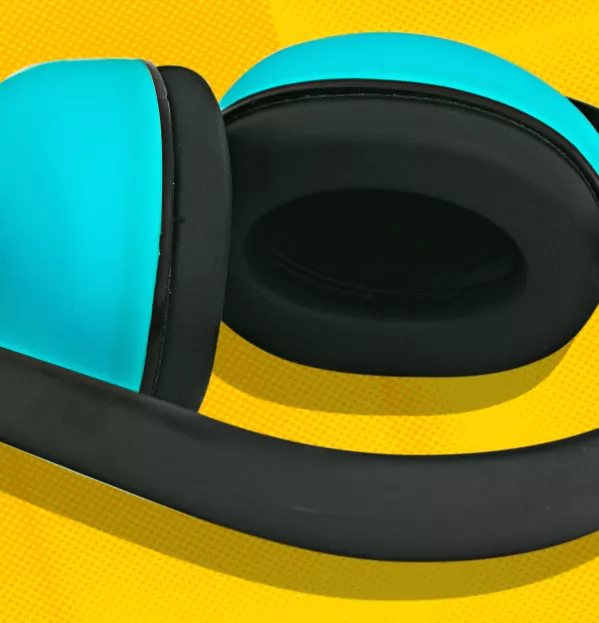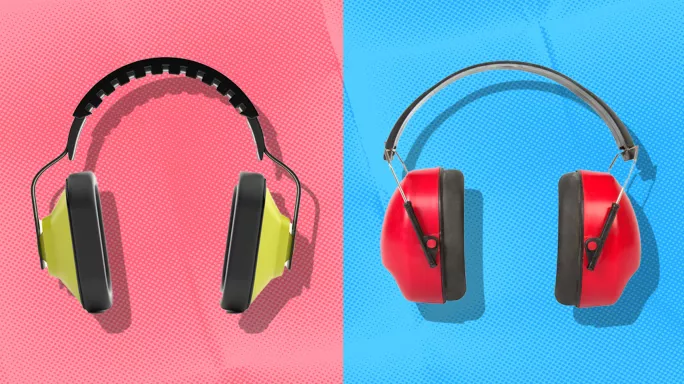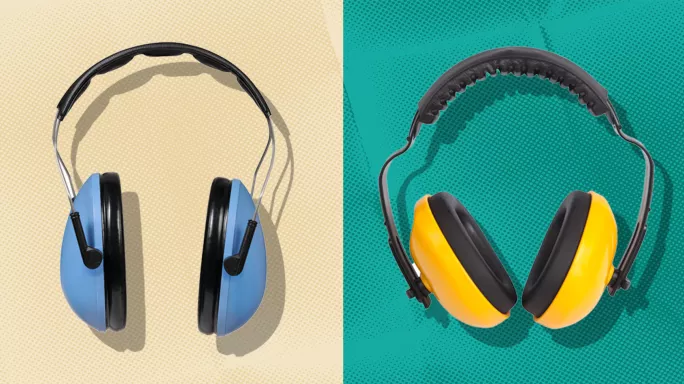- Home
- Teaching & Learning
- General
- The rise of ear defenders in schools: what teachers need to know
The rise of ear defenders in schools: what teachers need to know

Edith was struggling with the noise. It wasn’t that her primary school was particularly noisy but the whole-class conversations, one-to-one chats, the whirr of laptops, the scraping of chairs and the snotty noses were leaving her feeling overwhelmed. She was often upset and unable to work, and she found her class of nine-year-olds intolerable.
The Sendco suspected sensory processing issues and Edith was soon wearing a pair of bright pink ear defenders to support her in the classroom while her parents awaited a formal diagnosis. Edith’s progress and happiness at school seemed to improve rapidly.
Such a scenario has become increasingly common in schools since the pandemic. In a March 2024 Teacher Tapp survey of just over 7,000 teachers, 46 per cent said they had seen an increase in the number of pupils wearing ear defenders.
Ear defenders in schools
So what’s changed? Has there been an increase in sensory processing issues or is something else going on? And whatever the reason for more pupils struggling with noise, are ear defenders actually the right solution?
Ear defenders have been worn in noisy workplaces for at least a century. While there is no definitive turning point for their use in supporting sensory needs in education, they have certainly been seen in schools since the 1980s and 1990s in small numbers, usually being used by those diagnosed as autistic.
- Five ways to aid autistic children with sensory processing
- Open plan ‘super schools’ deemed bad for pupils with SEND
- Have you got the right mindset for inclusive practice?
Dr Ruth Reisman, an audiologist and lecturer at the City University of New York, explains that there could be a variety of conditions that explain why young people are choosing to wear ear defenders in the classroom.
“There are a number of different subtypes and symptoms,” she says. “Classic auditory processing disorder is a category in and of itself, meaning typically that there is no abnormality in the mechanical elements of sound - so the signal gets from the outer ear to the auditory cortex - but there is difficulty in the brain processing that auditory information.
“Then there are things like hyperacusis, which is like sensitivity to loud sound, which we see more in the autistic and the ADHD population and in some of the auditory processing population. And there’s phonophobia, which is fear of sounds - again we’ll see that a lot in those with sensory integration issues in general, and also in the autistic population. And then there’s misophonia, which is discomfort or a negative reaction to certain sounds.”
Could the Covid pandemic and its lockdowns have had an impact on the prevalence of these conditions or are there other elements at play?
It’s hard to know, Reisman says, but research has linked those who had coronavirus with cases of tinnitus and the experience of “brain fog”, which can have an impact on memory and auditory processing skills (which, she adds, can be rehabilitated).
However, Reisman explains that there has also been an increase in advocacy and awareness around all kinds of health concerns, including both hearing issues and neurodivergence. That could have led to an uptick in the adoption of support solutions without there necessarily being a higher prevalence of auditory challenges.
“So the question,” she asks, “is what came first?”
Whether it is the result of more awareness or more need - or both - schools are clearly having to find support mechanisms for more children in this area.
Leyla Gambell, a Sendco in an English secondary school, says that she has had to issue guidance to staff “to support the increase in requests for noise-cancelling devices”. At her school, if a student asks to wear any kind of ear defender or in-ear product, their head of year will investigate by talking to their teachers to confirm whether would be a benefit to the student before permission is granted.
Other schools are taking a different approach and proactively offering ear defenders to children as a tool to aid concentration when they are struggling.

In either situation, parental involvement is key, as demonstrated by a thread on parents’ forum Mumsnet from last summer. The concerned post creator explains how their five-year-old daughter has been flagged up as being “very distracted” in class, and so a teacher has offered her ear defenders to wear without consulting her parents.
The ensuing conversation exemplifies the debate that is springing up around the use of ear defenders: the parent feels confused and annoyed that her daughter has potentially been treated as if she is neurodiverse without an assessment, while many respondents challenge that ear defenders are simply another tool in the classroom, comparable to a pencil grip or a cushion, and that the teacher should be praised for trying to help.
Whatever a parent’s view is, talking to them should be the first step that a school takes, says Margaret Mulholland, special educational needs and inclusion specialist at the Association of School and College Leaders.
“Parental knowledge is really important,” she adds. “It’s important that they are part of the decision-making process as to whether ear defenders would be helpful or not, because all children are different.”
Staff need to be able to have conversations about how wearing ear defenders might impact positively and negatively on the child’s sense of self, Mulholland says, and parents will have “a better understanding of that”.
“Some children are going to love standing out and having something distinct, and for others that might be really uncomfortable”, she explains. “Parents will sometimes come up with some brilliant additional ideas about things that have worked at home to make them feel comfortable.”
“They’re just part of the daily equipment that the children and schools need now”
Daniel Woodrow, headteacher of St Gregory CEVC Primary School in Suffolk, says schools like his are having to become more accustomed to such conversations.
“Ear defenders and noise cancelling devices have really taken off and I think there are lots of reasons for that,” he says. “We’re more aware now that there are more children who are sensitive to particular sounds or noises and we’ve noticed that as children join the school, things like that are more of an issue for them now.”
He ponders whether this could be a result of the long periods of homeschooling experienced by most young people during the pandemic. He suggests that they may have got used to being in quiet spaces for a lot of the time and so the presence of 30 other children - and the level of noise and distraction involved in that - may be leading them to take refuge in the dialled-down sensory experience of wearing ear defenders.
“But I also think ear defenders have just become normalised,” Woodrow explains. “And I think, as schools, we’ve become more aware that they’re a good thing. I think training for staff has improved, so people are more aware of them as an option.
“They’re just part of the daily equipment that the children and schools need now. When we go out on a trip, the questions will be: ‘Have we got the first aid kit? Have we got the inhalers? Have we got the ear defenders?’”
But what impact are they having on learning? For Woodrow, any tool that enables young people to feel “safe and more ready to access learning” should be thought of as a win.
“[Pupils] have fewer distractions, and that’s good,” he says. “And how many of us adults wear headphones when we’re out and about or when we’re doing things? We block out the noise and find it easier to focus, or we have music on in the background when we’re working.

“There are lots of tools like that, that people use every day. And I think having something that blocks out unwelcome and distracting noises and allows children to feel safe and focused on their learning is a really positive thing.”
But could the use of ear defenders actually harm students’ ability to focus in the long run?
Guidance from NHS Derbyshire on young children wearing ear defenders counsels against overuse, warning that they can become “a tool by which children can live apart from their environment in a sound ‘bubble’”.
The guidance offers a series of recommendations, including limiting their use to “critical events such as the walking journey to/from school, going into the school dining room or assembly, being near a busy road, going into a public toilet where there are hand driers or when the vacuum cleaner/food mixer is used”.
It also advises that, with children who use ear defenders, staff should gradually build them up to going longer periods without them - a practice known as desensitisation. During this process, the ear defenders should be kept nearby so that they can be picked up as needed.
“Easy access to the ear defenders will reduce anxiety that the child might experience about possible trigger events, and enable them to have control over their auditory/hearing environment,” it recommends.
“However, it is important that children are exposed to challenging sounds in a way that enables them to learn how to cope with the sounds when not wearing the ear defenders.”
So should teachers be monitoring how often ear defenders are used in their classrooms? Should they be trained in the process of desensitisation?
Reisman says this could be useful for staff. The ideal, she explains, is to be “habituating” young people to environments that can be challenging in terms of sound. But she cautions that their central nervous systems are still “plastic” as they are “evolving and developing”, and so by relying on ear defenders, there is a danger that we are not “teaching the brain to process things in a normal manner, but training it to run away from sounds”.
Are some pupils too reliant on them?
Speaking anonymously, which perhaps shows the sensitivities around the issue, there are headteachers who admit that they do fear some pupils have become too reliant on ear defenders.
Both those in the mainstream and special school sectors fear that by removing the sensory stimulus that is causing difficulty for a young person, schools may be inadvertently removing the opportunity for the pupil to acquire the ability to manage it.
This, they argue, could be harmful to students in later life: while shutting out noise may well help them to concentrate in the classroom, it will not help them to be ready for other situations where they will encounter large groups and noise, from future workplaces to the bustle of a busy high street.
Another concern for some schools is the nature of the in-ear products being used.
Gambell says there is “an increasing number of different types” available, with some students reporting that “loops are better for dulling out all sound, flares are better for taking the edge off”. Picking the right option can require expertise that schools do not have.
Meanwhile, Simon Tanner, national director of special educational needs and disabilities for E-ACT multi-academy trust, says there are also important conversations to be had about the specifics of requests.
“A couple of people have spoken to me about how parents have asked for pupils to wear ear defenders but are wanting to use electronic versions with Bluetooth capability and whatnot,” he says.
This is a “very fine line”, he explains: while some neurodiverse students will listen to music or white noise in class for therapeutic reasons - “And for some that’s incredible, it has real value and purpose in keeping them calm, so that they can then access education and learning”, Tanner says - loosening the rules around headphones in general to allow this to be more widespread could cause difficulty for others, not least around formal exams.
“I think the danger for me is that it’s easy to go down the path of Bluetooth headphones,” he says. “They’re small, discreet and you can get that noise cancellation function as soon as you turn them on, and it drowns out everything. But the difficulty is that you can’t then use those when it gets to GCSE exams.”
He has seen schools tackle this with a simple policy of only allowing over-ear noise-reducing ear defenders to be used. And while these are definitely more noticeable, the thinking goes that the young people who “really need them” will opt for them because of the difference they make.
“The schools are saying, ‘Right, we will allow you that reasonable adjustment to wear the noise-cancelling headphones, but you can’t wear your Bluetooth version because you’re not going to be able to wear those all the way through.’
“We would be doing them a disservice if we were to let them wear these for four years and then get to GCSEs and say they have to take them out.”
So the issue of blocking out noise in schools is clearly a difficult one, with plenty of complexity for teachers to navigate. Most say that knowing the child well and supporting their individual needs is important, so this should be reflected in the school policy. Open and frequent communication with parents and other professionals is also key - and concerns over too much use need careful consideration.
The bigger picture of inclusion
Mulholland adds that constant evaluation of practice is crucial.
“I think it’s all about how they’re used in the classroom,” she argues. “Because any scaffold, of any kind, can be used well or not.”
But she says that the conversation about ear defenders also feeds into a wider, more philosophical one about how we treat our various needs as humans.
“Something that always really stuck with me from Erasmus projects was how wonderful it was in Iceland that in the schools everybody had a hook for their coat and a hook for their ear defenders - they were used by everybody,” she says.
She draws a comparison with automatic doors and escalators providing greater accessibility, arguing that “what’s good for some people is good for all - it’s not just for those who can’t”. And she says that schools should remember this when considering the needs of pupils.
“If children are dependent on ear defenders,” she says, “it’s partly because, as a system, we’re telling them they’re different and then they rely on them to be able to navigate difference.
“And that’s where I think we’re still part of the problem, because we’re saying, ‘Use these because you’re different,’ rather than, ‘These are just one of the things that help all of us.’”
For the latest research, pedagogy and practical classroom advice delivered directly to your inbox every week, sign up to our Teaching Essentials newsletter
You need a Tes subscription to read this article
Subscribe now to read this article and get other subscriber-only content:
- Unlimited access to all Tes magazine content
- Exclusive subscriber-only stories
- Award-winning email newsletters
Already a subscriber? Log in
You need a subscription to read this article
Subscribe now to read this article and get other subscriber-only content, including:
- Unlimited access to all Tes magazine content
- Exclusive subscriber-only stories
- Award-winning email newsletters
topics in this article



